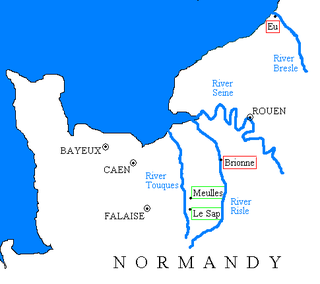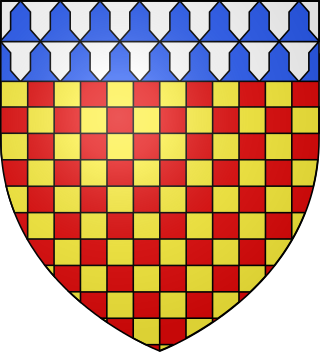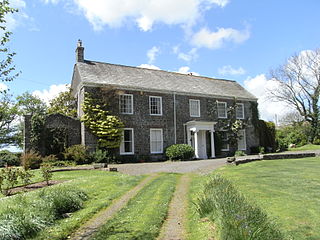This article possibly contains original research .(July 2013) |
The Manor of Loxhore was a manor in the parish of Loxhore, North Devon, England.
This article possibly contains original research .(July 2013) |
The Manor of Loxhore was a manor in the parish of Loxhore, North Devon, England.
In the Domesday Book of 1086 it was a double manor, part of the historic Shirwell Hundred and was one of the 176 landholdings in Devon held in-chief by Baldwin de Meulles, Sheriff of Devon, who held the largest fiefdom in Devon and was the first feudal baron of Okehampton. These two holdings are thought to correspond to today's division of the parish into (Higher) Loxhore, where is situated the parish church, and Lower Loxhore, two miles south in the valley bottom of a small tributary stream of the River Yeo. Prior to the Norman Conquest of 1066 the part called Lochesore was held by the Saxon Doleswif, whilst the other, called Locheshore, the entry following it, was held by Wulfward. Before 1066 both paid tax at the same sum, for 1/2 a hide, and both were valued in 1086 at 20 shillings. Wulfward's former holding contained more arable land, and 4 more villagers, but less pasture and woodland than Doleswif's. Wulfward's holding also contained 4 acres of alder-grove, the presence of which wetland-loving trees may suggest his estate was Lower Loxhore, and that Doleswif held the estate on higher ground where now stands the parish church. Baldwin de Meulles' tenant of both holdings as listed in Domesday Book was "Robert de Beaumont".
In the Domesday Book of 1086 the twin holdings of Loxhore were two of at least four manors held in Devon by the Norman magnate Robert de Beaumont, 1st Earl of Leicester, Count of Meulan (c. 1040/50-1118) as a mesne lord from Baldwin de Meulles. [1] William the Conqueror had granted Robert about 91 English manors in several counties as recompense for his service in the Norman conquest of England. Loxhore, along with Ashford (east of Heanton Punchardon) and Shirwell, stayed for many generations within the Beaumont family. [2]

The earliest positively identifiable descendant of the Domesday tenant Robert de Beaumont was the 13th-century Sir Richard Beaumont, whose family had long been seated at the capital estate of Youlston within their adjacent manor of Shirwell. His eldest son and heir was Philip Beaumont (died c. 1272), of Youlston, and his younger son was William Beaumont "of Sabrecot" (i.e."Sepscott"), to whom he granted the manor of Loxhore. Sepscott survives today as an estate about 3 miles south of Youlston, and 7 miles south-west of Loxhore Church, and was anciently known as Sabrecot, Shebescote et al., [4] and this branch of the family eventually inherited Shirwell also, on the failure of the senior male line. Philip Beaumont (died c. 1272), of Youlston married Ermengard Punchardon (originally de Pont-Chardon), daughter and co-heiress of Sir John Punchardon of Heanton Punchardon in Devon. His son was Sir John Beaumont (died 1330), of Youlston, MP for Devon in 1326, who married Alice Scudamore. [5] His son was John Beaumont who married Alice, of unknown family. His only son and heir was William Beaumont, who died without progeny leaving his sister Joan Beaumont, the wife of Sir James Chudleigh, as his heiress. She too died without progeny and the Beaumont estates, now enlarged by the addition of the Punchardon lands, passed to her cousin John Beaumont (died 1378/80), of Sepscott, grandson of William Beaumont, who had been granted Loxhore by his father Sir Richard Beaumont, and son of Richard Beaumont. John Beaumont married Joane Crawthorne (or Crawstone), the heiress of her grandfather Sir Robert Stockey, MP in 1318. He purchased the North Devon manor of Parkham. [6] Their son was William Beaumont, Sheriff of Devon in 1399, [7] who held the Castle and Borough of Barnstaple. He further increased the family's estates by marrying Isabel Willington, daughter of Sir John Willington of Umberleigh, and co-heiress of her brother John Willington (died 1396). Their son was Sir Thomas Beaumont (1401–1450), born at the Willington manor of Yate in Gloucestershire. He married twice, the offspring of which two marriages became successively heirs to his estates. Firstly he married Phillipa Dynham, daughter of Sir John Dynham and aunt to John Dynham, 1st Baron Dynham (died 1501) [8]

Arlington was a manor, and is a village and civil parish in the North Devon district of Devon in England. The parish includes the villages of Arlington and Arlington Beccott. The population of the parish is 98.

Umberleigh is a former large manor within the historic hundred of (North) Tawton, but today a small village in North Devon in England. It used to be an ecclesiastical parish, but following the building of the church at Atherington it became a part of that parish. It forms however a part of the civil parish of Chittlehampton, which is mostly located on the east side of the River Taw.

Baldwin FitzGilbert was a Norman magnate and one of the 52 Devon Domesday Book tenants-in-chief of King William the Conqueror, of whom he held the largest fiefdom in Devon, comprising 176 holdings or manors. He was feudal baron of Okehampton, seated at Okehampton Castle in Devon.

Heanton Satchville was a historic manor in the parish of Petrockstowe, North Devon, England. With origins in the Domesday manor of Hantone, it was first recorded as belonging to the Yeo family in the mid-14th century and was then owned successively by the Rolle, Walpole and Trefusis families. The mansion house was destroyed by fire in 1795. In 1812 Lord Clinton purchased the manor and mansion of nearby Huish, renamed it Heanton Satchville, and made it his seat. The nearly-forgotten house was featured in the 2005 edition of Rosemary Lauder's "Vanished Houses of North Devon". A farmhouse now occupies the former stable block with a large tractor shed where the house once stood. The political power-base of the Rolle family of Heanton Satchville was the pocket borough seat of Callington in Cornwall, acquired in 1601 when Robert Rolle purchased the manor of Callington.

Whitechapel is an ancient former manor within the parish of Bishops Nympton, in north Devon. It was the earliest known residence of the locally influential Bassett family until 1603. The core of the present manor house is late 16th or early 17th century, with later additions and alterations, and was classed as Grade I listed on 9 June 1952.

The historic manor of Raleigh, near Barnstaple and in the parish of Pilton, North Devon, England, was the first recorded home in the 14th century of the influential Chichester family of Devon. It was recorded in the Doomsday Book of 1086 together with three other manors that lay within the later-created parish of Pilton. The manor lies above the River Yeo on the southern slope of the hill on top of which stand the ruins of the Anglo-Saxon hillfort called Roborough Castle. Part of the historic manor of Raleigh is now the site of the North Devon District Hospital.

Sir John Chichester, 4th Baronet of Youlston Park in the parish of Shirwell near Barnstaple, Devon was a British landowner and Tory politician who sat in the House of Commons from 1734 to 1740.

Hall is a large estate within the parish and former manor of Bishop's Tawton, Devon. It was for several centuries the seat of a younger branch of the prominent and ancient North Devon family of Chichester of Raleigh, near Barnstaple. The mansion house is situated about 2 miles south-east of the village of Bishop's Tawton and 4 miles south-east of Barnstaple, and sits on a south facing slope of the valley of the River Taw, overlooking the river towards the village of Atherington. The house and about 2,500 acres of surrounding land continues today to be owned and occupied by descendants, via a female line, of the Chichester family. The present Grade II* listed neo-Jacobean house was built by Robert Chichester between 1844 and 1847 and replaced an earlier building. Near the house to the south at the crossroads of Herner the Chichester family erected in the 1880s a private chapel of ease which contains mediaeval woodwork saved from the demolished Old Guildhall in Barnstaple.

Sir Hugh Courtenay of Boconnoc in Cornwall, was twice a Member of Parliament for Cornwall in 1446–47 and 1449–50. He was beheaded after the Battle of Tewkesbury in 1471, together with John Courtenay, 7th Earl of Devon, the grandson of his first cousin the 4th Earl, and last in the senior line, whose titles were forfeited. His son Edward Courtenay, 1st Earl of Devon, was created Earl of Devon in 1485 by King Henry VII, following the Battle of Bosworth and the closure of the Wars of the Roses.
The Manor of Bratton Fleming was a medieval manor estate in Bratton Fleming, Devon, England.

Richard Coffin (1456–1523), of Alwington and Heanton Punchardon in North Devon, was a Sheriff of Devon.
The Manor of Shirwell was a manor in North Devon, England, centred on the village of Shirwell and largely co-terminous with the parish of Shirwell. It was for many centuries successively the seat of two of the leading families of North Devon, the Beaumonts and their heirs the Chichesters of Raleigh, Pilton, both of which families were seated at the estate of Youlston within the manor of Shirwell. The manor house which survives today known as Youlston Park is one of the most architecturally important historic houses in North Devon and exists largely in its Georgian form, but retains many impressive late 17th-century interiors.

John Basset (1518–1541) was an English gentleman from Devon, a member of the old Basset family, and heir to a substantial inheritance. His short life is well documented in the Lisle Papers. He studied law at Lincoln's Inn and at the age of 20, at the start of a promising career, entered the household of Thomas Cromwell, Lord Privy Seal, but died suddenly aged only 23, albeit having married and produced a son and heir, born posthumously. His stepfather and father-in-law was Arthur Plantagenet, 1st Viscount Lisle, Lord Deputy of Calais (1533–1540), a bastard son of King Edward IV and thus uncle of King Henry VIII, whose arrest with that of his mother in 1540 at Calais for heresy and treason, was a major, potentially catastrophic, event in his life. He died a year after the arrests, from an unknown illness, but his siblings all went on to have successful careers, especially his younger brother James, mostly as royal courtiers, apparently unaffected by the crisis.
East Hagginton was a historic estate within the manor and parish of Berrynarbor near to the coast of North Devon. It is near to, if not actually encompassing, the site of Watermouth Castle.

The feudal barony of Okehampton was a very large feudal barony, the largest mediaeval fiefdom in the county of Devon, England, whose caput was Okehampton Castle and manor. It was one of eight feudal baronies in Devonshire which existed during the mediaeval era.

Philip Beaumont (1432–1473), lord of the manors of Shirwell in North Devon and of Gittisham in East Devon, was a member of parliament for a constituency in Devon and was Sheriff of Devon in 1469. He was the rightful heir of his elder brother William Beaumont (1427–1453), a substantial landholder, but faced claims to his inheritance from his bastard nephew, John Bodrugan, "The Beaumont Bastard", the illegitimate son of Joan Courtenay, William's wife.

Thuborough in the parish of Sutcombe, Devon, England, is an historic estate, formerly a seat of a branch of the Prideaux family, also seated at Orcharton, Modbury; Adeston, Holbeton; Soldon, Holsworthy; Netherton, Farway; Ashburton; Nutwell, Woodbury; Ford Abbey, Thorncombe, all in Devon and at Prideaux Place, Padstow and Prideaux Castle, Luxulyan, in Cornwall. The present mansion house, comprising "Thuborough House" and "Thuborough Barton", the north-east block, is a grade II listed building.

Gittisham is an historic manor largely co-terminous with the parish of Gittisham in Devon, England, within which is situated the village of Gittisham. The capital estate is Combe, on which is situated Combe House, the manor house of Gittisham, a grade I listed Elizabethan building situated 2 1/4 miles south-west of the historic centre of Honiton and 3 1/4 miles north-east of the historic centre of Ottery St Mary.

Sir Robert Basset (1573–1641), lord of the manor of Umberleigh and lord of the manor of Heanton Punchardon in Devon, England, was MP for Plymouth in 1593.
The Manor of Heanton Punchardon was a manor in the parish of Heanton Punchardon, Devon, England.